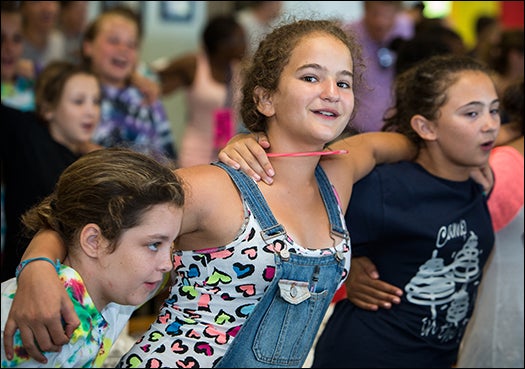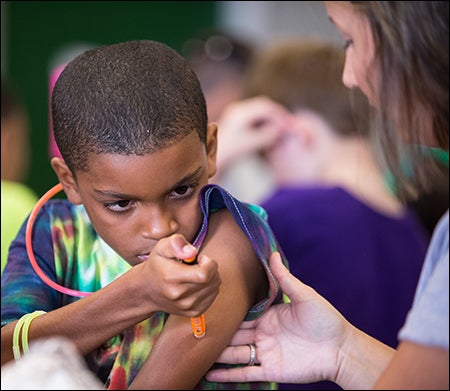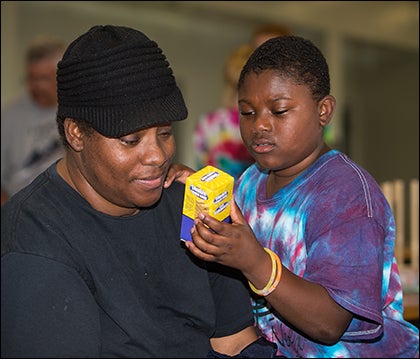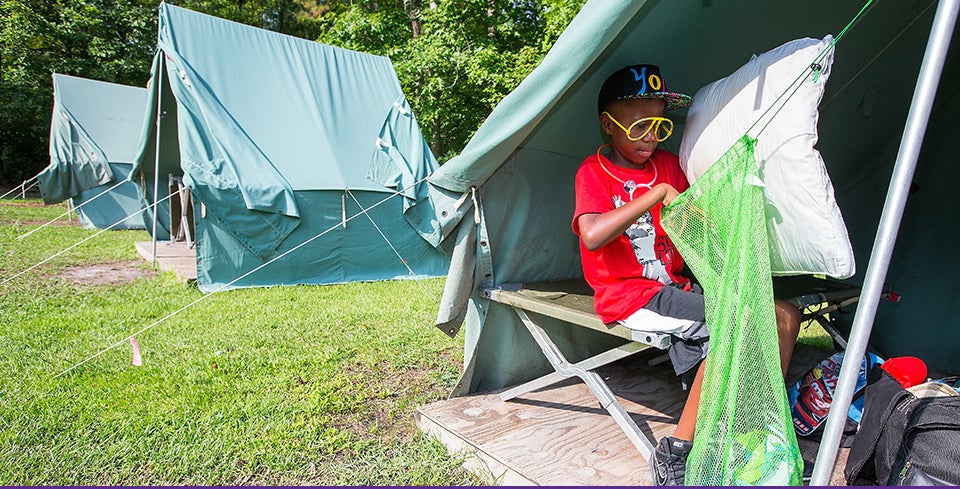INDEPENDENCE DAYS
INDEPENDENCE DAYS
Right after breakfast on the final day of Camp Needles in the Pines, the director led 75 young campers in a rousing rendition of the camp song, complete with hand motions and foot stomping.
“…Mosquitoes may eat us
but they’ll never beat us
‘cause we’re from Camp Needles
and we’re on the ball!”
The group belted out several more rounds – each one faster than the previous one – the campers undaunted by the increased momentum. When the song ended, the counselors and medical professionals scattered about the cabin applauded, assured the happy campers would be departing with newfound knowledge and confidence.

Campers join in song during the last day of camp at Camp Needles in the Pines.
A one-week residential camp on the banks of the Pamlico River in Blount’s Creek, Camp Needles is offered annually by the Brody School of Medicine’s Department of Pediatrics for children ages 8-14 with Type 1 diabetes. Diabetes is a condition in which the body doesn’t produce enough insulin to convert certain types of foods, like sugar and starches, to energy.
This year’s camp, held July 26-31, marked 30 years that Brody has provided the educational camping experience for eastern North Carolina’s children.
“I met a lot of new friends, and we stayed up until 11 o’clock,” said 9-year-old camper Sidney Boone of Salemburg.
“I shot a bow-and-arrow. I’ve never done that before. I ate lasagna and I liked it. I floated on the river. We found a lot of clams but we threw them back,” she said.
Boone was recently diagnosed with diabetes and she wears an insulin pump, a computerized device that regulates blood sugar levels by continually delivering insulin through a catheter placed under the skin. She was awarded a ribbon during the week for trying out a new type of finger-pricking instrument to check her blood sugar level.
Boone’s mother Christy said she and her husband don’t have diabetes, so they were hoping the camp would help them better understand what it means to be a diabetic. “I was petrified to send her because this was her first time away from home,” she said, “but I hope she’s gained some independence.”

Malachi Wilkins checks his blood sugar with help from Priscilla Spivey, an ECU nurse specialist.
Camp director Lynne Braxton, a nurse and certified diabetes educator with Brody’s pediatrics department, has been involved with the camp since its inception, when insulin pens and pumps did not exist. “Lots of newly diagnosed children don’t come because they’re so overwhelmed at first, but it’s a great way for them to learn important self-help skills,” she said.
“We don’t see anywhere near the numbers of low blood sugar we saw years ago because we’ve gotten so much better at matching food and activities to the children’s levels,” she said.
“We’re able to plan ahead for specific activities, to count the grams of carbs in different foods and match the insulin dose to that. And we’re teaching the children how to apply these principles at home. The goal is more independence.”
At first glance, the only thing distinguishing Camp Needles from any other summer camp is the smattering of red plastic containers – used for safe needle disposal – atop some of the picnic tables. The campers have the chance to engage in typical camp fare from tubing to tenting to tie-dyeing. But as they learn to navigate crafts and canoes, they’re also learning to navigate the challenges of their disease with help from the medical professionals and counselors who volunteer there.
There are doctors from East Carolina University and other local offices on-site all week. There are nurses, nutritionists and diabetes educators, too. “So often, the staff only get to see these kids in the hospital and clinic where we have to be ‘rule enforcers,’” Braxton said. “It’s so rewarding for us to see them healthy and having fun and just being kids.”
Many Camp Needles counselors are living with Type 1 diabetes, so they are not only familiar with needles, they know firsthand the importance of having adult role models who are successfully managing the disease.
One such counselor is Melvin Cox of Lillington, a high school math teacher who’s attended Camp Needles for 23 years – the first two as a camper, the rest as a counselor.
“As a young person with diabetes, this was the only place I ever went where I felt like everyone was like me,” he said. “I learned more about my diabetes here than I ever would’ve learned on my own or at the doctor’s office. Seeing that I wasn’t the only one having that experience was so valuable.”

Sherinetta Smith, left, and her son Marvin spend time together at Camp Needles in the Pines. Smith attended the camp herself when she was a teenager.
Cox said his favorite moment of the week was watching a child administer her own insulin injection for the first time. “Some parents tend to be overprotective,” he said. “But with just a little bit of work, these kids can do stuff every other kid can do.”
Devante Harris, a 9-year-old from Cary, said he was already looking forward to returning next year. “When I get home, I’m probably going to check my blood sugar a whole lot more,” he said. Another camper said he would be more diligent about wearing shoes – “so I won’t cut my feet,” he said.
Diabetics should avoid open wounds because the body is more susceptible to infection when blood sugar is high, Braxton explained.
Sherinetta Smith of Kinston said when her 9-year-old son, Marvin Wright, was diagnosed with diabetes at age three, she “cried and cried.”
Living with Type 1 diabetes herself, she knew the challenges he would face. She was also worried about sending Marvin to Camp Needles for the first time this summer because he’d never been away from her before.
But Smith herself had attended Camp Needles when she was 13, and her fond memories won out over the worry. “That’s where I learned I wasn’t the only young person with diabetes,” she said. “And I learned I could do whatever anyone without diabetes could do as long as I learned to manage it. I knew Marvin needed to be around other children with diabetes, too.”
In this case, mother knew best, as evidenced by Marvin’s emphatic first words to his mother when she arrived to take him home. “I just want to stay here,” he said.
